Archive for September, 2007
September 30, 2007 at 8:59 pm · Filed under Uncategorized
31 degrees at 8:30 a.m. / -97 amp-hours cumulative (24 amp-hours used overnight)
Yesterday a couple known to Bert and Janie through the Outdoor Writer’s Association showed up. Eric and Sue are a photographer/writer team who have been published just about everywhere. Last night Eric showed us some incredible photos he’d captured of a Great Gray Owl here in Yellowstone, and we resolved to go out to the same spot and find that owl again.
So began the Great Gray Owl Hunt. We hit the road in the late morning and pulled off about 20 miles from our campsite in the area where the owl was known to be living. This was the moment I’d been waiting for — not to see the owl, but to simply have a chance to go tramping around in the forests of Yellowstone on a beautiful clear day in September.
Up to this point all of our explorations had been roadside. In Yellowstone, that’s where most people should remain. There are dozens of interesting pullouts and sites to see, and you don’t really have to hike the backcountry to get a good feel for the park. In fact, it’s better if the average yahoo doesn’t leave the roadway because they aren’t equipped to stay safe in a region where bears, bison, and boiling water are concealed around every turn.
There’s a book you can find in the visitor centers called “Death in Yellowstone.” It documents all the interesting ways people have managed to kill themselves here. Some of them are just painfully stupid (a tourist trying to mount a wild bison, or feeding a grizzly bear) and others are more the result of inadequate foreknowledge (freezing to death after getting lost, stumbling over an elk carcass that a bear had already laid claim to, falling through the fragile sinter surface near a thermal area, etc.). Anyway, if you don’t know what you are doing, it’s best to stick to the roadside attractions. A can of bear spray and a “never say die” attitude does not constitute sufficient preparation for a backcountry hike.
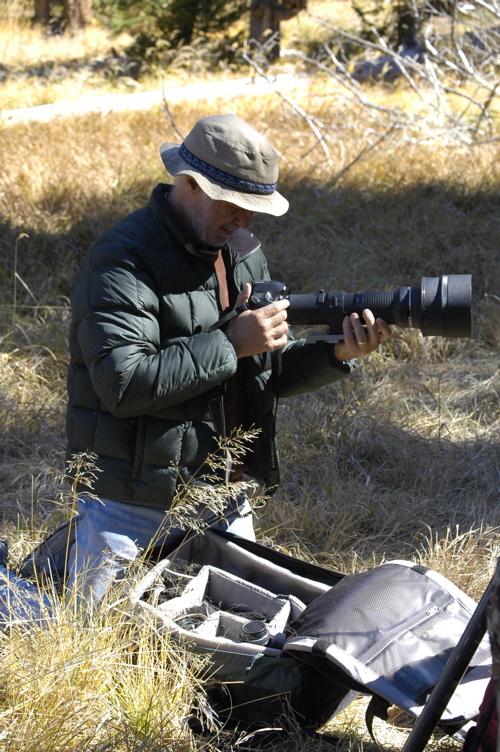 Our little hike was more of a meander. Bert, Janie, Eric, and I all split up and explored separate quadrants of the search area, checking dead trees high and low for the large gray owl. The sky was blue, the air was comfortable (about 45 degrees with no wind), and the forest was filled with interesting things. We found a clump of bison fur, a mud wallow, all kinds of scat, elk bones, volcanic rocks, some gray jays, a woodpecker, and even — gulp — an elk carcass (fortunately too far gone to be of interest to anyone except insects). But no gray owl.
Our little hike was more of a meander. Bert, Janie, Eric, and I all split up and explored separate quadrants of the search area, checking dead trees high and low for the large gray owl. The sky was blue, the air was comfortable (about 45 degrees with no wind), and the forest was filled with interesting things. We found a clump of bison fur, a mud wallow, all kinds of scat, elk bones, volcanic rocks, some gray jays, a woodpecker, and even — gulp — an elk carcass (fortunately too far gone to be of interest to anyone except insects). But no gray owl.
I didn’t really care at all. It was so pleasant and beautiful everywhere we went that I was happy just to roam around in the meadows and trees, crunching through the dry grass and finding little natural items to show Emma later. I think we all felt that way, because after two or three hours of hunting the owl we were all in great spirits and not really disappointed. I would have been happy to pitch a tent and stay there for a few days, just listening to the trees and the bird calls.
In the evening Eleanor told us of a large male elk posing in the meadow adjacent to our campground. Bert and I headed over and caught some nice shots of this fellow and his three cows at sunset. He has seven prongs on one side, and eight on the other. Six prongs on a side is a “royal”, seven prongs is an “imperial” and eight prongs is a “monarch”, according to the ranger at Rocky Mountain National Monument.
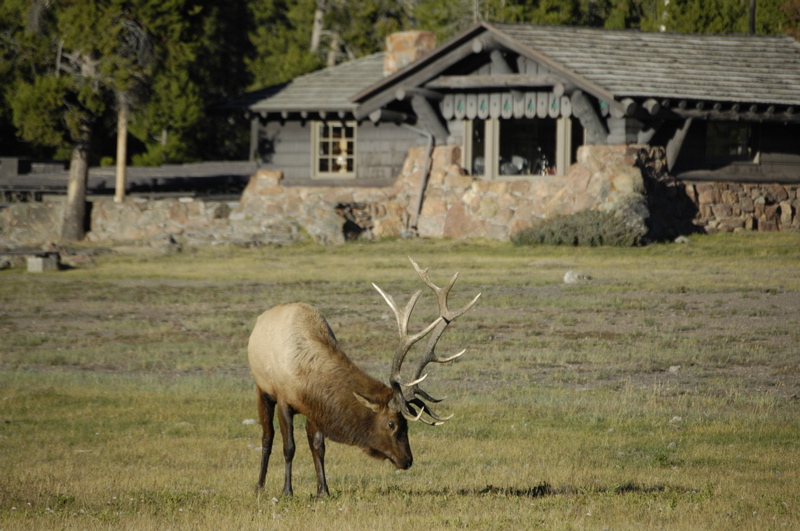
We weren’t the only ones taking pictures this evening. Everywhere you go in Yellowstone, photographers are out with huge lenses and tripods, snapping away at the wildlife. Everyone wants to get that perfect shot, and when they’ve got it, they go back for more because you can always hope to find a better one.
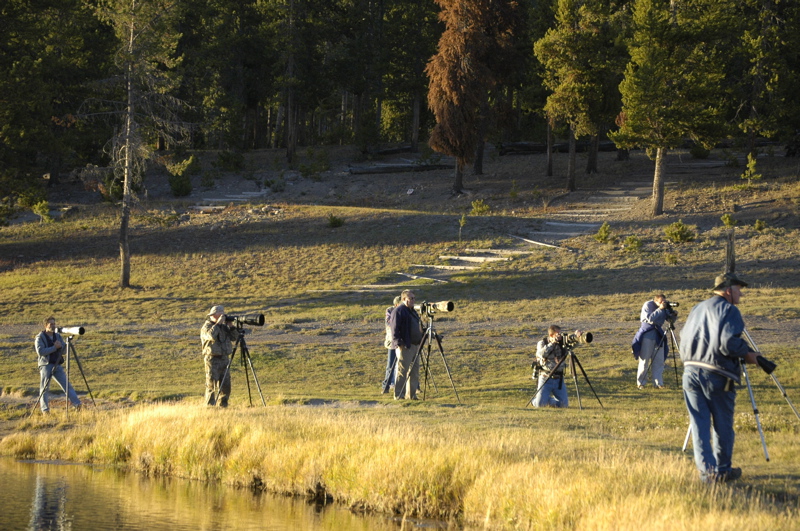
I can understand this. Normally when I’m shooting I have to work fast and hard, capturing images under time pressure before we move on or the subject does. Here in Yellowstone, I was able to slow down and take photos for the sheer pleasure of it. Bert and I stood out in the grassy field for over an hour just shooting this one bull elk as he ate, herded his cows, bugled, and finally sat down at sunset. A dozen other photographers were there the entire time as well. It was a fun exercise taken for no other reason than simply wanting to stay and observe this magnificent elk.
Our solar gain report for the day:
Clear. At 7 p.m. cumulative amp-hours were -67. 30 amp-hours gained.
September 29, 2007 at 7:43 pm · Filed under Uncategorized
41 degrees at 8:00 a.m. / -70 amp-hours cumulative (25 amp-hours used overnight)
It was surprisingly warm last night, thanks to a blanket of cloud overhead, but the gray skies have wrought havoc with our solar budget and our outdoor activities.
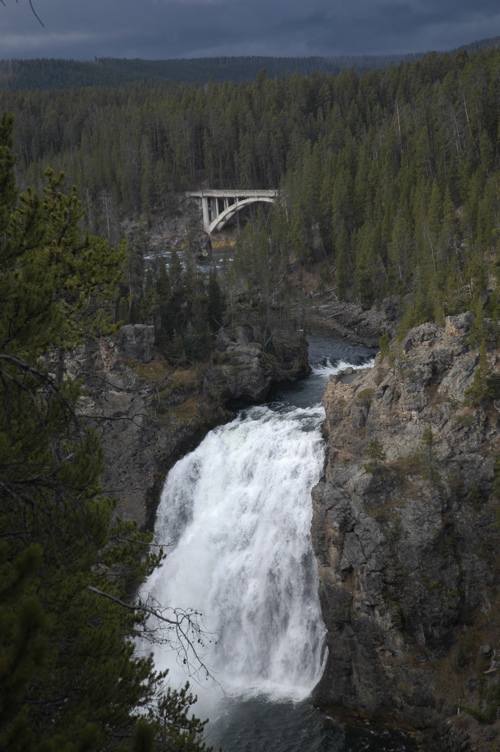 We started with a ranger talk at “The Grand Canyon of Yellowstone”, in a light rain, but soon the temperatures fell and by the end of the talk we were being snowed on. Emma was thrilled.
We started with a ranger talk at “The Grand Canyon of Yellowstone”, in a light rain, but soon the temperatures fell and by the end of the talk we were being snowed on. Emma was thrilled.
Despite a general chill, we dropped in on the Norris Geyser Basin and Artists Paintpots (bubbling mud pots that put on a most entertaining show of burping).
As I expected, Bert volunteered to let us use his generator for re-charging, but my estimate at this point is that we can still easily last for five nights. In fact, we’ve decided to stay an extra day so we can join the Gildarts for a tour of the Grizzly and Wolf center in West Yellowstone on Monday. We’re not using the laptops much, nor the cell phone, and with stringent power conservation measures it looks like our net loss per day will run about 24-27 amp-hours per day. That’s no problem for the four-battery bank installed in our trailer.
Work-wise I know that taking Monday off will probably cause me some grief, but I’m enjoying being disconnected so much that I’ll take my chances. I haven’t dropped out of sight for more than a couple of days since last March, when we went to Organ Pipe Cactus National Monument, and Mexico.
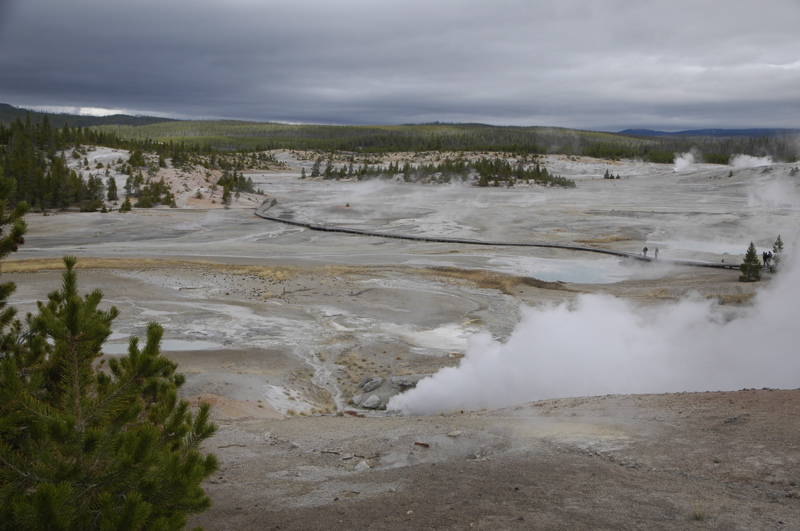
Part of the Norris Geyser Basin
Our solar gain report for the day:
Cloudy. At 7 p.m. cumulative amp-hours were -73. 3 amp-hours lost.
We actually lost ground today rather than gaining. It was quite cold and gray all day and so the furnace was required in the afternoon, when normally the trailer would stay warm just from the sun shining on it. This is the first time I can recall that we’ve netted less power during the day while on solar, which just shows the huge impact the furnace has on our overall power budget.
September 28, 2007 at 7:23 pm · Filed under Places to go
29 degrees at 8:30 a.m. / -71 amp-hours cumulative (43 amp-hours used overnight)
This morning I followed Bert and Janie on our first photo expedition. Our goal was elk but we didn’t spot any for hours. We did see a lot of bison, which are everywhere. Here, a bull bison is using his tongue to help sniff the air for eligible females. The bison rutting season was earlier this summer, but he holds out some hope for a late bloomer.
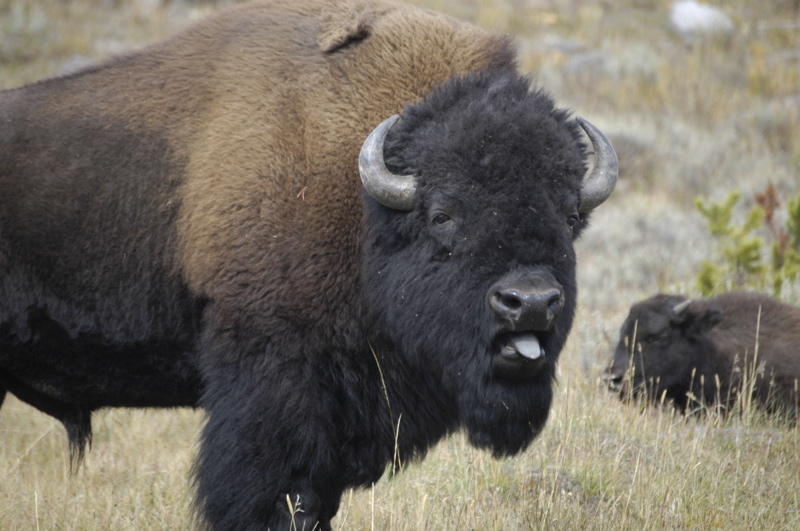
I followed Bert and Janie as far as Hayden Valley and then headed back to camp to take Eleanor out to see a few sights. Emma was deeply enthralled by her new friends and would have preferred to just stay at camp.
Of course, less than a mile from the campground (in the opposite direction we’d gone in the morning) we found a herd of elk calmly munching grass and moss and posing for pictures. This female elk is sporting a popular piece of elk fashion, a radio collar. Quite a bit of research goes on in this park.
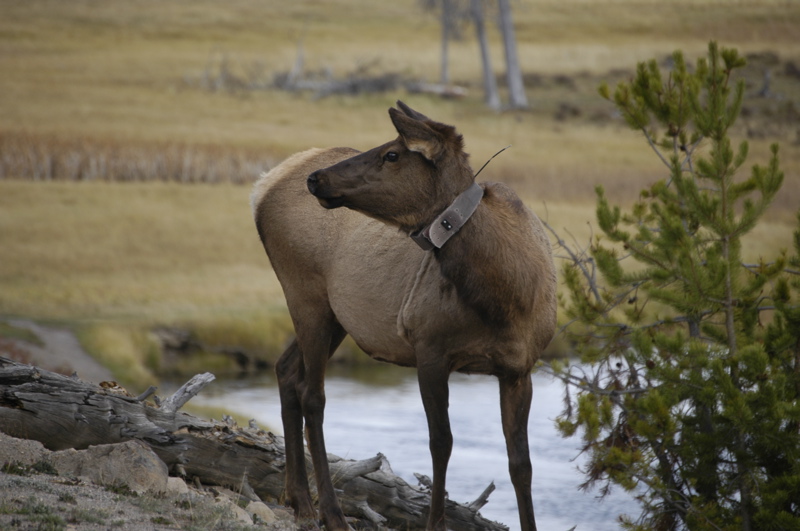
I have been reading a book entitled “High Endeavours: The Extraordinary Life and Adventures of Miles and Beryl Smeeton”. This very honest biography seems a good companion to our traveling life. Miles and Beryl were incredible thrill-seekers and travelers. I can’t do justice to the stories of their travels, so I’ll just say that this is one I can recommend if you want an inspirational look into the minds of a pair of serious travel junkies. Their travels ranged from Beryl’s 500-mile solo walk through the jungles of Burma and Siam during the monsoon, to several round-the-world sailings in their 46-foot yacht. The book is probably out of print but I found a copy through Alibris.
In order to avoid having to hitch up and tow the Airstream to the dump station, we are on extreme water conservation tactics. We are using the campground bathrooms most of the time (which are fortunately heated, although there’s only cold water), and washing all dishes in the sink the campground provides as well. With this we should easily be able to last five nights without dumping or refilling our fresh water tank.
Our solar gain report for the day:
Partly cloudy. At 5 p.m. cumulative amp-hours were -45. 26 amp-hours gained.
Even with slightly more clouds than yesterday, we still gained about the same amount from the panels. Extrapolating, it looks like we will exit the park on Monday with the batteries down about 125 amp-hours, which is still within our safe limit. We’ll be fine as long as the sun keeps shining.
September 27, 2007 at 7:19 pm · Filed under Places to go
It must have been the excitement of being here, because Eleanor and I were both wide awake at 5 a.m., lying there in our comfortable warm bed while frost covered the bedroom windows, and we could not manage to get back to sleep. I finally got up and fired up the stove to make some Cream of Wheat with maple syrup for breakfast. On cold mornings, especially when we are really “camping” in a national park, hot breakfast seems to be called for.
The overnight low was 27 degrees. We had set the furnace at 58 degrees and piled all our blankets onto the beds, so it was pretty chilly when I got up. The Tri-Metric battery monitor said we had consumed 55 amp-hours of power, most of which was to run the furnace, and looking at the shade of the lodgepole pines I could tell we weren’t going to be able to recoup that with our solar panels. The power budget was going to have to be reduced.
To facilitate this, I started logging the daily temperatures, sun conditions, and power use/gain. This morning’s entry looked like this:
27 degrees at 8:30 a.m. / -55 amp-hours cumulative (-55 amp-hours net)
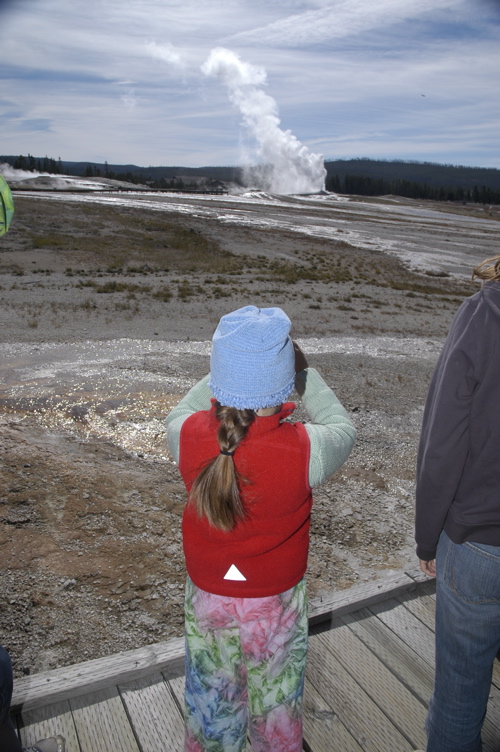 Somewhere in the campground were the folks we’d met in Cody, Yves and Marta. I unfolded the Birdy bike, put on all my warm clothes (long underwear, two shirts, windproof pants, heavy socks, fleece, jacket, hat, gloves) and rode around Madison campground to see if I could spot them.
Somewhere in the campground were the folks we’d met in Cody, Yves and Marta. I unfolded the Birdy bike, put on all my warm clothes (long underwear, two shirts, windproof pants, heavy socks, fleece, jacket, hat, gloves) and rode around Madison campground to see if I could spot them.
Riding in 27 degrees is really not bad if you’re dressed for it. It reminded me of many bike rides I had done in Massachusetts in the late fall when we lived there in the 1990s. I liked it enough that I took a few extra loops through the campground that weren’t strictly necessary, just for the pleasure of riding.
I might have had a chance to find Yves and Marta if I had a clue of their last name, the color of their tent, or the vehicle they were driving, but I had failed to get any of that information back in Cody. It looked like our chances of meeting up were slim to none.
Still, on the bike ride I did see the first of many bison, and off in the distance I heard an elk bugling. It was just too exciting to stay in the trailer much longer, so we woke Emma up and headed over to Old Faithful to attend a 10:30 ranger talk. Of course there I ran into Yves and Marta …
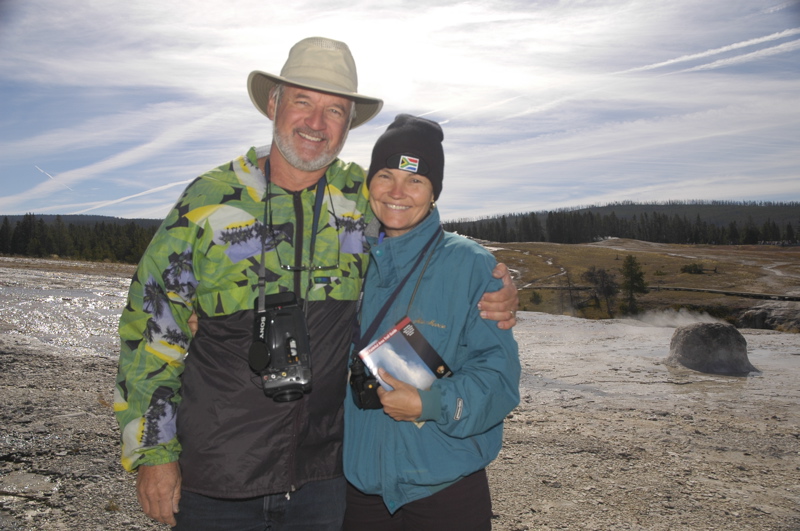
I have to admit that I was surprised to find them, since they were tenting in sub-freezing temperatures, but when I asked they exclaimed, “We couldn’t leave, not while the weather is so nice!” And it was nice with the sun shining on the geysers. We made plans to meet up in the evening.
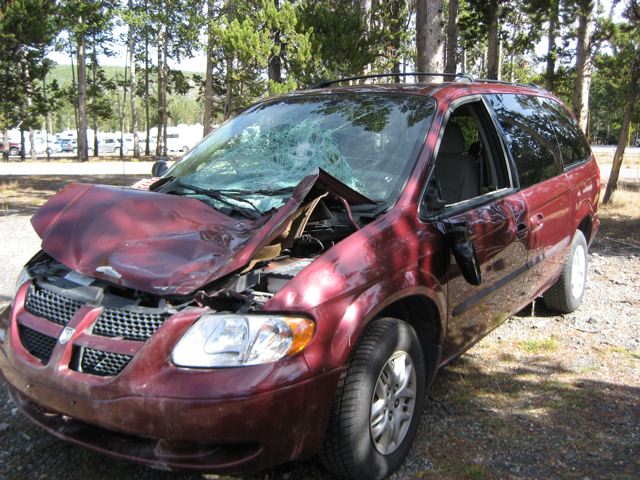
While at Old Faithful we found the car that hit the elk … a reminder that there’s a 45 MPH speed limit in the park for a very good reason.
 Emma quickly burned out on geysers, hot springs, and fumaroles, but Eleanor and I couldn’t get enough of them. I even like the sulphurous smell of the steam. The best ones are the deep boiling blue ponds that remind me of Florida springs, and the ones with orange thermophilic bacterial mats around the edges, like Grand Prismatic Spring.
Emma quickly burned out on geysers, hot springs, and fumaroles, but Eleanor and I couldn’t get enough of them. I even like the sulphurous smell of the steam. The best ones are the deep boiling blue ponds that remind me of Florida springs, and the ones with orange thermophilic bacterial mats around the edges, like Grand Prismatic Spring.
I’ll upload a pile of photos of geysers and other sights of Yellowstone to our Flickr photo album when I get a chance.
Of course Emma is working on a Junior Ranger badge while she is here. Last year she got the badge for the younger kids (identical to the older kids’ badge but following a different program), and this year she is working on the badge for the 8-12 year-olds. A minor disaster occurred along the way today, when a high wind blew a page of her booklet into a pool of boiling water. Needless to say, I didn’t jump in after it. Only in Yellowstone can such a disaster occur.
It was an important page, one which had been signed by a ranger earlier (to acknowledge that Emma had attended his talk). Fortunately, we were able to get a replacement page at the Old Faithful visitor center and found the ranger again for a replacement signature.
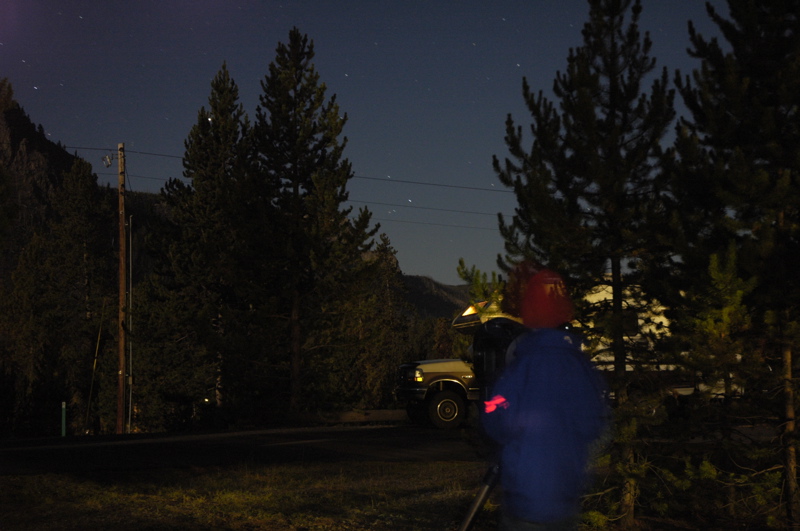 This evening Bert and Janie pulled in, towing their 28-foot Airstream. We introduced them to our neighbors, who had pulled out a large Meade telescope with computer control, and I tried some night photography while Jacob (the 10-year-old) worked with the scope.
This evening Bert and Janie pulled in, towing their 28-foot Airstream. We introduced them to our neighbors, who had pulled out a large Meade telescope with computer control, and I tried some night photography while Jacob (the 10-year-old) worked with the scope.
Around nine Marta and Yves showed up for a bit of late dessert and wine over our dinette. They turned out to be very interesting: Captain and Mate for hire on various boats, based in Cape Town South Africa, and now traveling the US for three months in their van and tent. I have no doubt that we will see them again in the next year, somewhere in the USA.
Our solar gain report for the day looked like this:
Clear skies. At 4 p.m. cumulative amp-hours were -28. 27 amp-hours gained.
So we gained more power than I had expected given the trees, but clearly my initial budget of 60 amp-hours per day needs revision if we are to last for five nights. The furnace is the problem, so tonight instead of setting the thermostat at 58, we’ll set it lower to 50 degrees. That’s actually fun, makes it feel more like camping.
September 26, 2007 at 7:25 pm · Filed under Uncategorized
We’re back from Yellowstone National Park and I’m backdating a week’s worth of blog entries now that I can once again get online.
From the moment you leave Cody, the road begins to climb and the scenery becomes stunningly rugged and fascinating. Even though Yellowstone starts about 40 miles away, it feels as though you’ve wandered off into the rocky wilderness almost immediately.
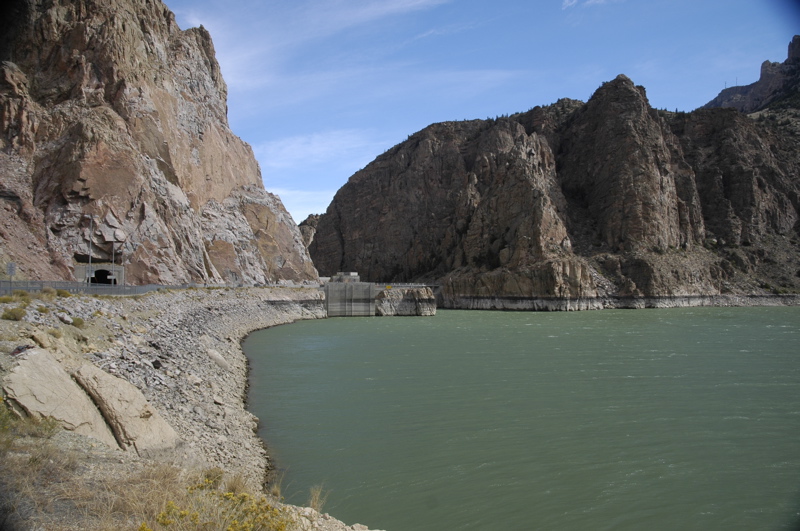 Two short tunnels and one long tunnel later, the first unexpected sight is a large reservoir and the Buffalo Bill dam. The dam was the tallest ever when it was built in the early 20th century, and a superb little visitor center will tell you all about it. The wind is also terrific, so fierce that steel bars atop the dam sing. Amazingly, you can walk out on the top of the dam and experience the awesome view and wind, even in this age of rampant security precautions.
Two short tunnels and one long tunnel later, the first unexpected sight is a large reservoir and the Buffalo Bill dam. The dam was the tallest ever when it was built in the early 20th century, and a superb little visitor center will tell you all about it. The wind is also terrific, so fierce that steel bars atop the dam sing. Amazingly, you can walk out on the top of the dam and experience the awesome view and wind, even in this age of rampant security precautions.
A little further down is Buffalo Bill State Park, right on the shores of the reservoir. We noted it for a visit next time. Cell phones work there, somewhat amazing considering the remote feeling of the place.
Last time we went to Yellowstone we were unimpressed by the crowding in July and August. Eleanor was frankly not thrilled to be back, thinking that it would be the same, but the crowds have left and the park is much more pleasant, although the frequent visitors tell us that for September it still seems crowded to them. The East Entrance, by the way, is now completely re-paved and makes a fine entrance once again.
At the Canyon Visitor Center we heard a fellow talking on his cell phone. (This briefly depressed me since it meant I could get online and work near Canyon, but I decided to file that information and not make use of it on this visit.) He was excitedly telling someone, “Did you hear what happened to me yesterday? I hit an elk!” He appeared uninjured, but I expect the elk didn’t get off quite as well.
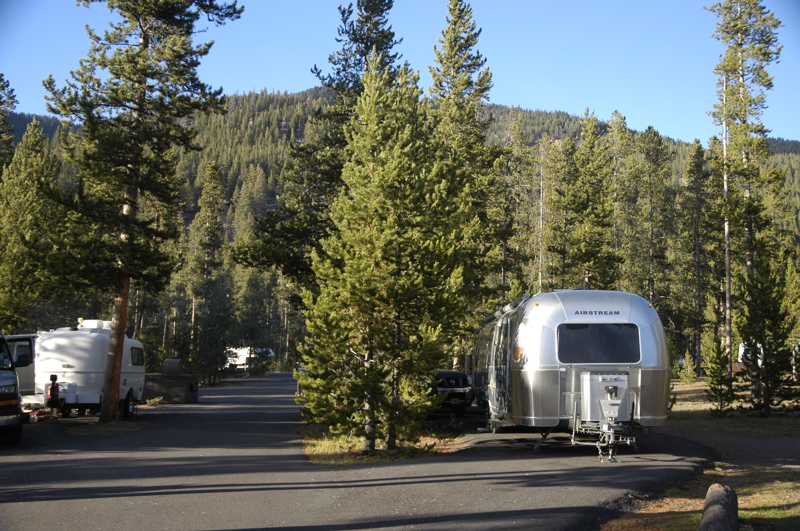
Sites at Madison campground are generally a bit tight for bigger RVs. We spent ten minutes wedging into our site so that we could park without scraping a tree or leaving a wheel off the pavement (there are fines for that). The other obvious problem is that our site is partially shaded by tall lodgepole pines to the east and west, which will reduce our solar gain to much less than I had anticipated. This could be a problem after five nights. Everyone else here seems to have a generator, and they run them a lot, probably because the nights are freezing.
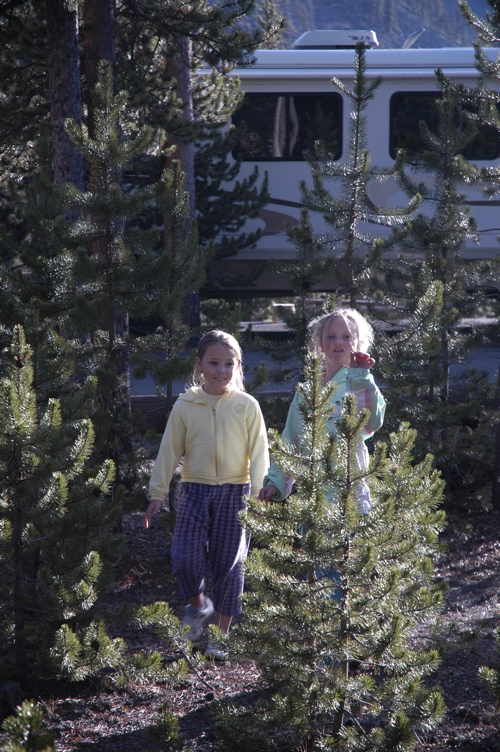 On the plus side, our neighbors have two homeschooled kids, ages 6 and 10, and Emma managed to make instant friends with them. They have a lot in common as a result of their schooling. We can tell homeschooled kids now just from their generally outgoing behavior and their comfortable attitude toward adults.
On the plus side, our neighbors have two homeschooled kids, ages 6 and 10, and Emma managed to make instant friends with them. They have a lot in common as a result of their schooling. We can tell homeschooled kids now just from their generally outgoing behavior and their comfortable attitude toward adults.
It’s time to make a small announcement: we have decided to continue homeschooling Emma for at least another year. It has been a great success and since her Montessori school in Tucson has had no openings thus far, we see no reason to stop traveling anytime soon. We gave Emma some placement tests for second grade and found she was pretty much on track or ahead of the game in all areas, so our confidence in our schooling technique has been raised. In the morning before we left Cody, we ordered a curriculum from the Calvert School which will be delivered to Bert & Janie’s house next week. I’ll talk more about that later.
September 25, 2007 at 11:09 am · Filed under Tips & Ideas
We don’t often voluntarily camp in freezing weather, but it’s more because of me than the Airstream. My interest in ice extends to skating, and cubes in my lemonade. Growing up in Vermont, I feel I have experienced enough cold weather to suit me for life. I can see the romantic and novelty factor of frost on the windows once or twice a year. After that, it’s time to move on.
However, if the weather does drop below freezing, the Airstream is not intimidated. I get a lot of queries from people about how we “deal with freezing,” or asking how cold a night we can survive. Really, it’s a non-issue for most Airstreams, because the trailers are reasonably well-insulated against a cold night. There are a few inches of pink fiberglass insulation in the belly pan (under the floor) and the walls and ceiling contain about two inches of insulation as well. All of the essential ductwork and plumbing runs in the insulated space, and of course we have a furnace, which sends some of the heated air to the holding tanks to keep them from freezing.
Last night it was close to freezing here in Cody. We usually set the nighttime temperature at 62, and at that setting the furnace ran several times during the night. Perfectly comfortable. Even at temperatures down into the teens, we won’t have any trouble staying warm inside the Airstream and nothing in the trailer will freeze. Our only precaution would be to disconnect the outside water line, so it doesn’t freeze solid.
A windy night makes it much harder to keep the trailer warm. RV’s are not air-tight, and between air leaks and cooling from the aluminum skin, it’s much harder to keep warm on a windy 30-degree night than on a still 20-degree night.
The real challenge occurs when we are camped without an electrical connection, because the furnace is a big hog of 12v electric power. This is going to be an issue in Yellowstone, since only one campground in all of Yellowstone offers RV hookups and we’re not going to that one.
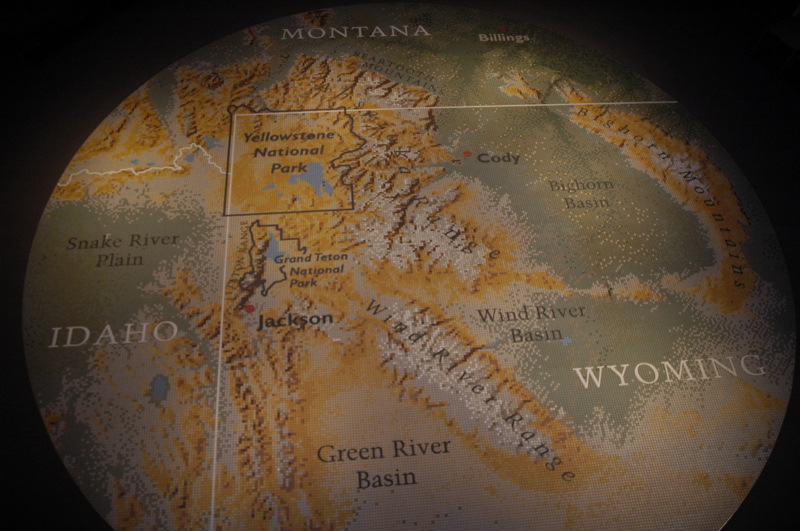
The furnace chews up about 7 DC amps when it runs, mostly to power a blower. Our battery bank is about 300 DC amp-hours, but we regard only half of that as “useful” power since we are trying to be gentle on the batteries (for long life). In a very cold night, the furnace can cycle on and off every few minutes, consuming 25-40 DC amp-hours by breakfast. Add to that our normal daily power usage and we might drain our batteries by 80-100 amp-hours per day. That means, without careful conservation, we can use up our useful battery capacity in two days.
Keep in mind also that we have four batteries, whereas most newer trailers have two (smaller trailers have just one). Others in this situation will wake up to find their batteries completely flat. They’ll also find they need to replace their batteries every year or two.
Of course, our two solar panels help us out. This time of year, with full sun, we can probably generate 40-50 DC amp-hours per day, which makes up half of our projected use. This means we can boondock in Yellowstone for four nights without draining the batteries below the safe threshold.
However, I’ve booked five nights in Yellowstone, and it will be freezing every night. That means we’ll have to conserve power. We do that by using light and laptops minimally, and setting the thermostat lower than usual at night. I think we’ll be able to keep our daily power budget under 60 amps per day. That’s going to be important, because if we blow the budget we’ll be reduced to borrowing the Gildart’s generator to make it through the last couple of cold nights. That would probably appear in Bert’s blog, and I can’t have that!
Speaking of which, there will probably be no blog entries from Wednesday night through Monday night, unless we happen to get lucky and park near someone who has a satellite Internet dish. The only place I can get online in Yellowstone is at Old Faithful, and I doubt I will be toting my laptop there. I’ll write daily entries while we are in the park and post them all when we exit the park in Montana on Monday night.
September 24, 2007 at 3:40 pm · Filed under Travel / lifestyle musings
Today is a “down” day, which is a good thing. Cody has gotten a little fall-like weather, with temperatures in the 40s and gray skies today, and we’re all taking the opportunity to stay close to home rather than doing tourist stuff.
Our Airstream is parked next to this campground’s “tent” area. A couple from Vermont with their six-year-old daughter were camped near us, and watching their tent through our window last night I was remembering long-ago nights in a tent in freezing weather with Eleanor. They spent the evening out, probably in a restaurant or local store, to avoid the chilly evening temperatures, while we were comfortable in the Airstream watching a movie and snacking on popcorn. I do like tent camping, but on a night like last night, I’m glad we have the Airstream. Our neighbors are heading into Yellowstone today, as their last stop before they have to head back east.
It won’t be any warmer in Yellowstone. This week when we go there it will be freezing every night and the warmest we will get in the daytime will probably be in the 50s. I’ve been digging through the storage bins of clothes under the bed, making sure my long underwear and warm socks are still there. Fleece hats and gloves are in the closet. Since we’re meeting Bert and Janie there, I expect to spend a day out in the cold stalking wildlife or some such thing with the camera. It’s good to be prepared for the worst when you go out with Bert. He has a knack for finding “interesting” situations.
Eleanor used some of her time today to clear out the freezer, defrost, and find some long-forgotten food that needs to be cooked soon. There was enough “snow” from the freezer to make a slushy for Emma, and now the trailer smells like Thanksgiving as Eleanor turns the various freezer surprises into something delicious.
Down days are an essential part of the full-time life. We do the sorts of things we used to do on quiet Sundays in fall back in Vermont: clean, putter, read, cook, and generally catch up on the little things. One of my things to do in town on a down day is to hunt up a local barbershop and get a month’s worth of haircut. Since I never know who is going to cut my hair, or what sort of job they are going to do, it helps to have low expectations. Usually Eleanor looks at my hair as I come in the door and scrunches up her nose, but today she actually liked what they did. Maybe I’ll have to come back to Cody for all my haircuts from now on.
Emma is doing homeschooling but she doesn’t realize it. She’s done a few pages in her math workbook, passed a little math test I made up for her, read a story, given me an oral book report, and now she’s writing in her “Book of Stories.” The best kind of homeschooling is the kind that is nearly invisible to the child.
The weather today reminds me that the days are getting shorter, and winter is really coming. We’ll experience a few weeks of cold (and damp, up in the Pacific Northwest), and then start down the west coast through California. Eleanor and I sat down with the atlas and a list of ideas, and worked out a tentative plan for the next two months. We’ll probably spend most of November traveling through inland California, with little side trips to the national parks that aren’t closed for snow, and eventually end up in Arizona by December. When we get there, I want a giant burrito from Nico’s. Then I’ll feel like I’m home.
Visiting California is like visiting an entire country. Tackling California is the hardest (and yet most appealing) planning task of all our full-time travels. It’s huge from north to south, and we have dozens of friends and acquaintances who live there — all of whom we want to see. The routing is nearly impossible and there’s no doubt we will keep tweaking it right up to the last minute. Where will we spend Thanksgiving? Do we want to go Point Reyes or Napa Valley? Route 1 or inland? Redwoods or San Joaquin Valley? How best to avoid the snow in the Sierra Nevadas, yet have a chance at Lassen Volcanic Park and Yosemite?
But these are fun problems to work out, knowing that no matter how we go, we will have a great time. I don’t know how to have a bad time in California. It’s a great state. And today, our “down day”, is the best time to work it all out.
Next entries »
 Our little hike was more of a meander. Bert, Janie, Eric, and I all split up and explored separate quadrants of the search area, checking dead trees high and low for the large gray owl. The sky was blue, the air was comfortable (about 45 degrees with no wind), and the forest was filled with interesting things. We found a clump of bison fur, a mud wallow, all kinds of scat, elk bones, volcanic rocks, some gray jays, a woodpecker, and even — gulp — an elk carcass (fortunately too far gone to be of interest to anyone except insects). But no gray owl.
Our little hike was more of a meander. Bert, Janie, Eric, and I all split up and explored separate quadrants of the search area, checking dead trees high and low for the large gray owl. The sky was blue, the air was comfortable (about 45 degrees with no wind), and the forest was filled with interesting things. We found a clump of bison fur, a mud wallow, all kinds of scat, elk bones, volcanic rocks, some gray jays, a woodpecker, and even — gulp — an elk carcass (fortunately too far gone to be of interest to anyone except insects). But no gray owl.















